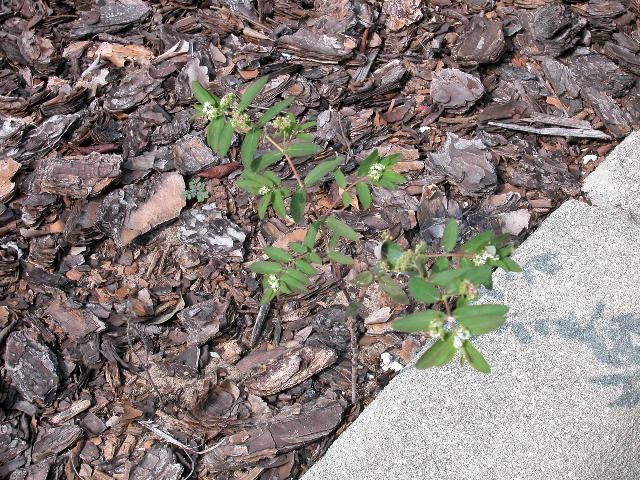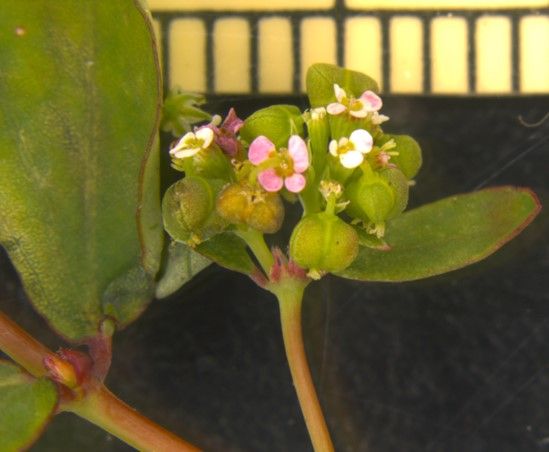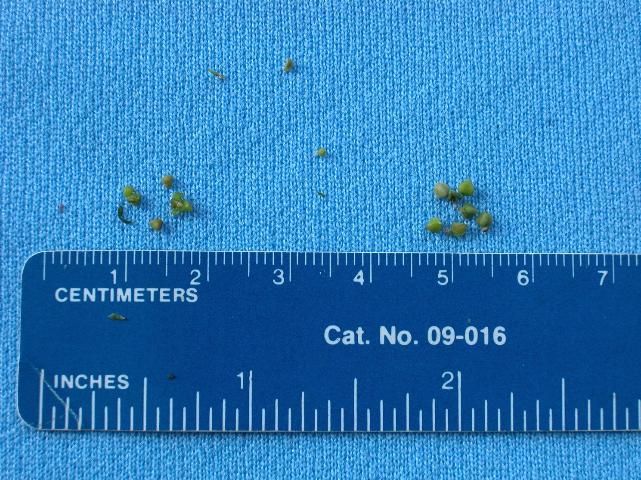Species Description
Class
Dicotyledonous plant
Family
Euphorbiaceae
Other Common Names
spurge, sandmat spurge, yerba nina (Hammer 2015)
Life Span
Summer annual
Habitat
Graceful sandmat occurs in pine forests, disturbed areas, roadsides, turf areas, landscape beds, and nursery containers. It is most often found in areas receiving full to partial sun. It can grow in dry or wet environments with a short hydroperiod and has been observed growing in wetland habitats and borders of marshes and ponds.
Distribution
Graceful sandmat is native to North America and is found throughout Florida, the southern United States, and other tropical and subtropical regions throughout the world (Chen and Wu, 2004; USDA, NRCS, 2015).
Growth Habit
Erect, upright growing herb (Figure 1)

Credit: Annette Chandler, UF/IFAS
Seedling
Cotyledons are dark green with round, opposite leaves and red stems.
Shoot
Graceful sandmat can grow over 2 ft tall but normally grows to less than 1 ft tall. Stems are round, thin (1 to 2 mm), red, and sometimes wiry but never woody. Leaves are purplish red to green, elliptic in shape, 1 to 2.5 cm in length, oppositely arranged, and have red petioles and red interpetiolar stipules (Figure 2). The base of the leaf is unequal. Leaf margins appear to be entire but are slightly denticulate (toothed or serrate) upon closer examination. Leaves are crowded toward the top of the stem while the lower portion of the stem is bare (due to leaf drop over time). All parts of the stem and leaves exude a milky sap when broken.

Credit: Annette Chandler, UF/IFAS
Roots
Weak taproot
Inflorescence
Small, cyanthia flowers with four reddish to white to green petals (Figure 3)

Credit: Theresa Chormanski
Fruit and Seeds
Fruit is a small, green schizocarp (dry fruit) that splits into three parts. Seeds are very small and are dark brown to black when mature.
Similar Species
While many types of sandmat are common in Florida nurseries, E. hyssopifolia is one of the species more closely related to E. hypericifolia and may be mistakenly identified as E. hyssopifolia. Both species have fruit and stems that are glabrous and are distinguished by the length of their stipules and fruit. Euphorbia hypericifolia has conspicuous stipules that are longer than wide (1–1.5 mm long) and shorter fruit (less than 1.3 mm long). Euphorbia hyssopifolia has inconspicuous stipules and longer fruits (more than 1.3 mm long) (Figure 4) (Wunderlin and Hansen 2008a, b).

Credit: Annette Chandler, UF/IFAS
Plant Biology
Graceful sandmat is a summer annual weed, but it can grow throughout the year in southern and central Florida if frost does not occur. The weed is fast growing and begins to flower and produce seeds when young. Seeds are generally produced from late spring to the end of fall. Populations can increase quickly because seeds have no dormancy requirement and can germinate immediately. Although little data exist on the optimal temperatures for E. hypericifolia germination, many spurge species such as E. supina have the highest germination rates between approximately 75°F and 85°F (Krueger and Shaner 1982).
Management
Physical and Cultural Control
Graceful sandmat is most problematic in container nurseries because it is often found growing in container media. Graceful sandmat can also grow in landscape beds and other disturbed areas. Due to its prolific seed production, graceful sandmat must be removed by hand when it is small and before it begins to flower and produce seeds. However, hand weeding is labor intensive because graceful sandmat produces a large number of seedlings, and the size and color of these seedlings make them difficult to see against the container media. Spurge (sandmat) germination is higher when seeds are exposed to light. Cochran et al. (2009) found that applying mulch at depths of 0.5 to 1.0 inch reduced germination of other spurge species, so similar mulching may also be an effective control against graceful sandmat.
Chemical Control
Preemergence
Most preemergence herbicides provide control of sandmats (Chamaesyce spp.). However, these species continue to be difficult to control due the number of seeds they produce and how rapidly they grow. Researchers have noted that in general, dinitroaniline herbicides (e.g., pendimethalin, prodiamine, etc.) are more effective than oxadiazon or oxyfluorfen (Neal and Derr 2005). Little data exist on the most effective herbicides for graceful sandmat; however, herbicides that provide control of other sandmat (or spurge) species will likely be effective. A partial list of preemergence herbicides labeled for use in ornamentals for control of Chamaesyce spp. is given in Table 1.
Postemergence
Contact and systemic (translocated) herbicides labeled for use in and around nurseries will control spurges. A list of postemergence herbicides labeled for use in nurseries and landscapes is available at https://edis.ifas.ufl.edu/wg059. Weeds should be sprayed when they are small and actively growing in order for the herbicides to work effectively and to prevent further seed production. When weeds are growing in container-grown crops, especially small containers, postemergence herbicides cannot be applied without causing potential damage to the ornamental crop. Growers should focus their efforts on increasing sanitation efforts, following proper cultural management practices, and using labeled preemergence herbicides.
Disclaimer
Mention of a commercial or herbicide brand name or chemical does not constitute a recommendation or warranty of the product by the authors or the University of Florida Institute of Food and Agricultural Sciences, nor does it imply its approval to the exclusion of other products that may also be suitable. Products should be used according to label instructions and safety equipment required on the label and by federal or state law should be employed. Pesticide registrations may change, so it is the responsibility of the user to ascertain if a pesticide is registered by the appropriate state and federal agencies for its intended use.
References
Chen, S. H., and M. J. Wu. 2004. "Chamaesyce hypericifolia (L.) Millsp., A Newly Naturalized Spurge Species in Taiwan." Taiwania 49:102–108.
Cochran, D. R., C. H. Gilliam, D. J. Eakes, G. R. Wehtje, P. R. Knight, and J. Olive. 2009. "Mulch Depth Affects Weed Germination." J. Environ. Hort. 27: 85–90.
Hammer, R. L. 2015. Everglades Wildflowers: A Field Guide to Wildflowers of the Historic Everglades, including Big Cypress, Corkscrew, and Fakahatchee Swamps. Lanham, MD: Rowman & Littlefield, 256.
Krueger, R. R. and D. L. Shaner. 1982. "Germination and Establishment of Prostrate Spurge (Euphorbia Supina)." Weed Science 30: 286–290.
Mallory-Smith, C. A., and E. J. Retzinger. 2003. "Revised Classification of Herbicides by Site of Action for Weed Resistance Management Strategies." Weed Technology 17 (3): 605–619.
Neal, J. C., and J. F. Derr. 2005. Weeds of Container Nurseries in the United States. Raleigh, NC: North Carolina Assoc. of Nurserymen, Inc.
USDA National Resources Conservation Service. 2014. "Chamaesyce hypericifolia (L.) Millsp. graceful sandmat." The PLANTS Database, http://plants.usda.gov
Wunderlin, R. P., and B. F. Hansen. 2008a. "Chamaesyce hyssopfolia." Atlas of Florida Vascular Plants. http://florida.plantatlas.usf.edu/Plant.aspx?id=3580
Wunderlin, R. P., and B. F. Hansen. 2008b. "Chamaesyce hypericifolia." Atlas of Florida Vascular Plants. http://florida.plantatlas.usf.edu/Plant.aspx?id=2803